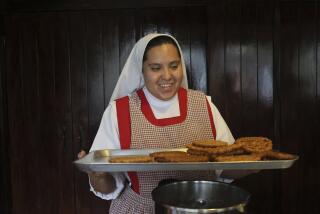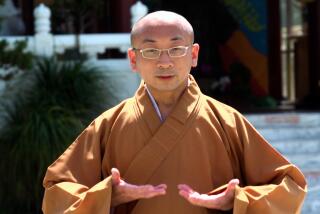On Chinese Frontier, Tibetans Reclaiming Their Lives, Culture
- Share via
ZHONGDIAN, China — With saws, chisels and thick beams of pine, Tibetans on a wind-swept plateau are engaged in a communal act of faith.
Half-built Buddhist temples two and three stories high and clusters of monks’ dormitories--the labor of 14 years--are rising from a hillock where radical communists once reduced the 300-year-old Gedan Songzan monastery to ruins.
Like the monastery, which a Buddhist emperor dubbed the “Temple of Transformation,” the Tibetans of the Diqing region are reclaiming their lives from the harshest intrusions of communist Chinese rule.
They practice their Buddhism and adore the Dalai Lama, hanging his picture in temples and on home altars. Local Communist Party politicians, many of them ethnic Tibetans, profess sympathy with Buddhism, and some even admire the exiled Dalai Lama.
But Diqing is part of China proper, not Tibet, and its people appear reconciled to Chinese rule. A mountain pass away, inside Chinese-controlled Tibet, photos of the Dalai Lama are banned. Monks and nuns are forced to denounce their spiritual leader as a separatist and charlatan. Officials seen as favoring the Dalai Lama are purged.
Diqing demonstrates that the Tibetan issue, popularly portrayed in the West as a straightforward case of mass religious persecution, is more complex. In remote places like Diqing, Tibetan culture passes less molested apparently because the locals don’t challenge Beijing’s authority. In Tibet, China has answered persistent calls for independence with relentless oppression.
If Chinese leaders ever sit down with the Dalai Lama to negotiate Tibetan autonomy--as President Clinton urged they do during his Beijing summit in June--Diqing may point the way to compromise.
From Diqing--in the southern province of Yunnan--to Gansu province in the north, visitors report a resurgence in Tibetan culture and little government interference all along the 600-mile frontier between Chinese and Tibetan civilizations.
From its broad valleys surrounded by snowy peaks to the flat roofs on towering houses, Diqing--pronounced DEE-ching--looks Tibetan. Women in colorful wool aprons haggle over the price of yak butter in markets. Buddhist pilgrims prostrate themselves on stone temple floors before gilded images.
Chinese shops line the streets of its towns, heirs to a centuries-old trade that brought Chinese tea through Diqing to exchange for Tibetan salt and wool. In recent decades, Chinese settlers have come to log the tree-covered mountains and open restaurants.
“People here get along with each other,” said Qi Zhala, Communist Party secretary for Diqing’s Zhongdian county, whose family came from Tibet 14 generations ago. His aide, Sun Jiong, a Chinese, calls the area “a model of stability.”
The ruin of nearly a half century of Chinese communist rule is everywhere evident. Elderly monks, some bent from years of forced labor, wander broken-down monasteries. Slopes once thick with pine trees are denuded.
Forests passed lightly touched until the Chinese brought commercial logging to the region in the late 1950s. Now provincial forestry officials estimate at least a fifth of the virgin pines are gone.
“The effect on the environment has been disastrous. Many places have become unfit for plant life,” Qi said. In an implicit criticism of Chinese rule, the county party leader noted that “Tibetans’ traditional outlook is that the forests should be protected.”
Tibetans, too, have shared in the exploitation. Chain saws buzz through supposed nature reserves cutting virgin pine for use in local houses.
Much of the Gedan Songzan monastery, once Diqing’s largest, lies in clumps of broken stone and charred beams scattered across a hillside outside the town of Zhongdian.
Officials carrying out Mao Tse-tung’s radical Cultural Revolution 32 years ago destroyed the 300-year-old temple in two weeks. To spread the complicity, every village in Zhongdian county was forced to send workers to take part in the destruction.
Those same villages have sent legions of hands and hundreds of thousands of dollars to rebuild the monastery since the government relaxed bans on religion in 1984.
Luozang Nangpo, the master carpenter who has supervised the reconstruction, had to learn the fine points of temple building in secret from an 80-year-old artisan during the Cultural Revolution.
“This is my contribution to religion,” Luozang said. “We Tibetans have to do this because we have the skills. The Chinese don’t.”
Eight residential colleges have been put up so far, housing 500 monks--still only a fraction of the 2,000 who once lived there.
For a sign of the complex ties at work in the renaissance, look at the monastery’s abbot, Luosang Tudan. He spent 32 years exiled in India with the Dalai Lama and the elite of Tibet’s religious hierarchy before returning to Zhongdian, his birthplace, in 1991.
“The Chinese government said they were supporting religious freedom. Teachers were needed for this monastery,” said the gaunt 61-year-old abbot as he issued blessings to leathery-faced farmers and young monks with freshly shaven heads in a small prayer hall.
The revival is not only religious. Excessive logging has been outlawed, and the local government is providing seed money to encourage start-up businesses and tourism as part of a campaign to raise incomes--now about $100 a year for farmers--and to preserve traditional culture.
Across the provincial boundary in Tibet, the Chinese government has made religion a battleground to strengthen its 47-year rule. Intent on wiping out separatist sentiment, Beijing launched a purge two years ago of Dalai Lama supporters among the strongly pro-independence clergy. One monitoring group estimates that nearly 4,000 clergy have been expelled.
Officials in Diqing insist there have been no purges, no denunciation campaigns and, also unlike Tibet, no limits on the numbers of monks and nuns in monasteries. Monks agree.
“Our government is concerned with the economy. They don’t bother us,” said Luosang Jumen, a 25-year-old monk at Gedan Songzan.
Still, if Luosang Jumen wants to fulfill his dream of traveling to India to see the Dalai Lama and study Buddhism, he will have to make the trip illegally, sneaking across the Himalayan frontier to evade border guards.
More to Read
Sign up for Essential California
The most important California stories and recommendations in your inbox every morning.
You may occasionally receive promotional content from the Los Angeles Times.













